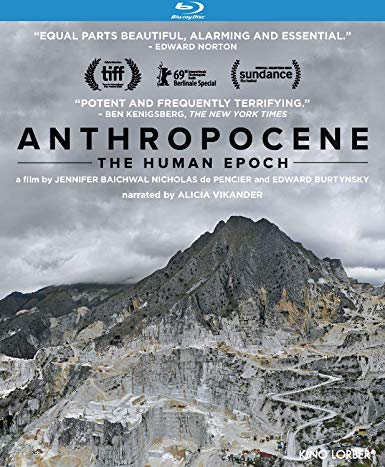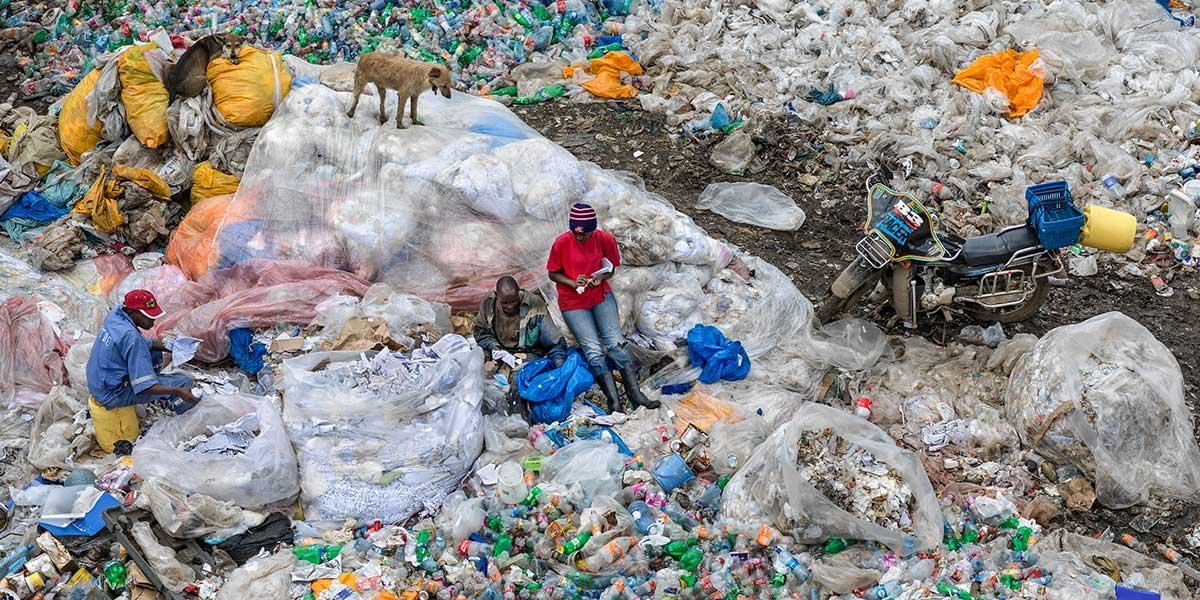Powerful Images Convey the Scale of Humanity’s Effect on the Planet.
DIRECTED BY JENNIFER BAICHWAL, NICHOLAS DE PENCIER, AND EDWARD BURTYNSKY / 2019
BLU-RAY STREET DATE JANUARY 21 2020 / KINO LORBER

Geologists divide the Earth’s 4.5 billion years into a series of geological epochs, each epoch denoting a massive change to the planet visible in rock layers. In 2008, a group of scientists proposed formally changing the current epoch, the Holocene, to that of the Anthropocene. This is because the effect of human civilization on the Earth has been so vast, it has changed the very face of the planet, perhaps for all time. Anthropocene: The Human Epoch is a documentary by a group of Canadian filmmakers that seeks to document these changes and make the case that because of those, we have passed into a new era. It uses imagery so startling and awesome in its scale, it begins to border on beautiful. But it feels very superficial in the end. The film does not allow itself the time to explore these issues in the depth they so justly require.
Anthropocene opens with images of a raging fire. Instantly you can tell this documentary isn’t going to be filled with truths anyone is going to want to hear. I know I’m going to need a strong drink for this one. This seques into images of elephant tusks being recaptured from poachers. 105 tons of tusks in this case, representing approximately 10,000 dead elephants. And I’m going to need another drink.

From there the movie takes us all around the world. From Norilsk, “the most polluted city in Russia,” (not a slogan you want on your welcoming billboards), to marble quarries in Italy, to coal mines in Germany, to massive landfills in Kenya and many more places where the size and scope of man’s effect on the environment is so large it can hardly be made sense of. There’s an excavating machine that dwarfs anything that appears in Star Wars. There’s a megachurch in Lagos, Nigeria that can seat a million people. A. Million. People. There are images of a potash mine in the Ural mountains that are so abstract it feels like we could either be looking at microscopic images or the face of an alien planet.
That the imagery (shot by Nicolas de Pencier) shown in the movie is beautiful and terrible all at once isn’t surprising. Edward Burtynsky, one of the co-directors, is a photographer who specializes in large format images of industrial landscapes. He’s worked with the other director, documentarian Jennifer Baichwal, before on their films Manufactured Landscapes and Watermark. I’m sorry I didn’t get a chance to see this on the largest screen available. Even on my (relatively) modest television, the cinematography is stunning.
But though the message is clear through the images the movie presents, there isn’t much depth here. We’re told, for instance, that Norilsk is the most polluted city, and that sounds terrible. But we aren’t shown what that means in terms of cost to the environment or the people who live there. We’re shown the town celebrating the twin ‘holidays’ of ‘Company Day’ and ‘Metallurgy Day,’ and it looks festive. There’s no real sense of irony here because we’re not shown what the company and metallurgy is doing to the town and its citizens. We’re told about that massive mega-church, and it’s impossible for me to get my head around a structure that big, but what does it have to do with anything? Is it an overpopulation issue?

Anthropocene knows how to use irony. There’s an interview of a worker in China who’s helping to build a seawall to combat the rising sea levels. Sea levels that are rising in response to climate change as a result of carbon emissions. Such as carbon emissions caused by the oil companies the Chinese worker is employed by. The oil company needs a seawall to protect itself from the results of the man-made climate change it denies is occuring.
I’d toast to that, but by this point in the film, I’m out of drink.
Anthropocene: The Human Epoch is presented on Blu-Ray by Kino Lorber in 1.78:1 aspect ratio, at 1080p. It comes with a short interview with actor Edward Norton, who is the United Nations’ Goodwill Ambassador for Biodiversity. It also comes with its theatrical trailer.


